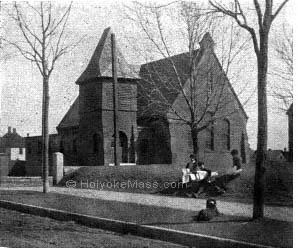
First Congregational Church.
|
Easterly are many acres of lowland still unoccupied, and there are various open squares in the more thickly populated districts vacant, except for a shed or two and some mammoth signboards. These fields are utilized by the children as playgrounds. Last fall there was a grand drill of soldiers i Holyoke, and play at soldiering at once became the fashion among small boys. I made a picture of one little company drilling with their wooden guns and swords. I Had hardly finished when a youth informed me that these little fellows I’d taken a picture of were "kids." He said, "I’ll get you out an army that’s something like, if you’ll take ’em." He expressed great contempt for the "kids," and for me too, when I would not agree to his proposition.
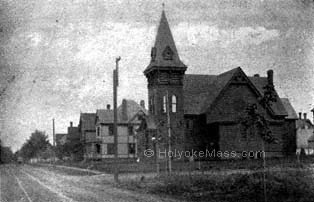
Highland Methodist Church.
|
It was on a near street, one frosty autumn morning, that I met a stumpy, red-faced little man, followed by a small dog. In the far distance, up the almost deserted street, was a little girl, her arms filled with grocery parcels, yipping and calling to the dog at a great rate. The man seemed disturbed, and as I passed him he cast an eye in the girl’s direction and said sarcastically, "You’ll never be lonesome while that kid’s around."
One more will end this list of street incidents. I was in a narrow alley below High street, getting a group of children into order, when a back door opened and forth came a man. He looked over my group and began talking with me. "There," said he, singling out one of the little fellows, "that boy keeps his face clean. He’s all right. I don’t know about those others. I’d rather not have them around here." It was a little odd to measure character by the dirt or lack of it on a boy’s face, and yet, after all there is some sense in the idea.
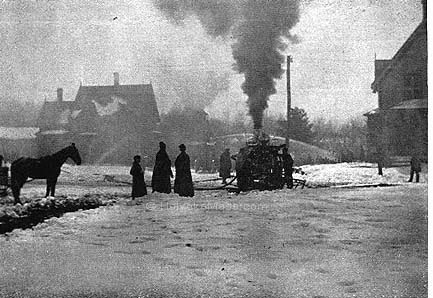
A Fire On the Highlands.
|
The dam is the source of the city’s prosperity and the most striking feature of the city’s surroundings, and one more visit to it before closing this article seems fitting. We will enter the picket gate and follow the narrow plank walk leading to the brick building over the gate where the water is let into the canal. From beneath the building the waters come in a surging, boiling flood. There is a dash of big waves and a spiteful plunging about the arches of the gatehouse, that greatly impresses one with the power of the water. It almost seems alive — like some mighty giant bound to toil, who would be free and chafes beneath his burden. Inside the gatehouse is an apartment where is a big boiler, and a small room containing a bed and a few chairs, and decorated on its walls with a few photographs and theatrical posters, and a long corridor where is the machinery to shut the twelve great gates. A gateman occupies the building. There is not a great deal to do ordinarily, but a pile of floodwood on the northern platform of the building show him to be industriously inclined, and in the season he catches lamper eels. The gateman has a monopoly of this eel business, and with nets, hands or prong he secures great quantities of them. They are repulsive looking creatures, but no doubt taste better than they look.
Holyoke is famed the world over as the "Paper City." For the size and number of its paper mills no other city is its equal. About two hundred tons of paper are manufactured there each day, and in its various forms there is hardly a nook or a corner of the globe where civilized man has penetrated but that this reaches. But the city’s interests are not confined to paper making. The center of the place is filled with factory after factory, foundries and machine shops, all teeming with active, bustling life. Silk, cotton, woolen and worsted fabrics, thread, iron and steel wire, screws, tools and machinery in great variety, lumber, wood pulp, files cutlery — this is but a partial list of its industrial enterprises. An impression of the business done may be strongly illustrated by the fact of its being the second place in the state in regard to its freight tonnage. It has a delightful situation on the long semicircle of the hills, and all its upper portion is a charming residence region. As to the business sections where the big mills line the canals, that means prosperity, and in the rippling waterways with the high-walled attendant factories looming above them, the imaginative will catch hints of Venice. May the city’s prosperity be long continued, and its attractiveness multiply with the passing years.
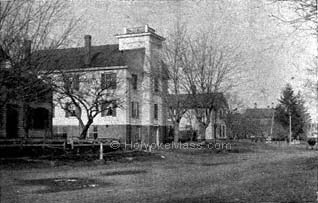
The Old First Congregational Church.
|
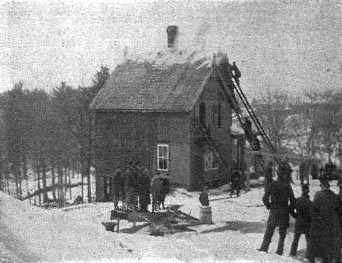
The Burning House.
|
© Laurel O’Donnell 1996 - 2006, all rights reserved
This document may be downloaded for personal non-commercial use only
and may not be reproduced or distributed without permission in any format.
This is an edited adaptation from the original publication.
|